Use of captured German anti-tank guns
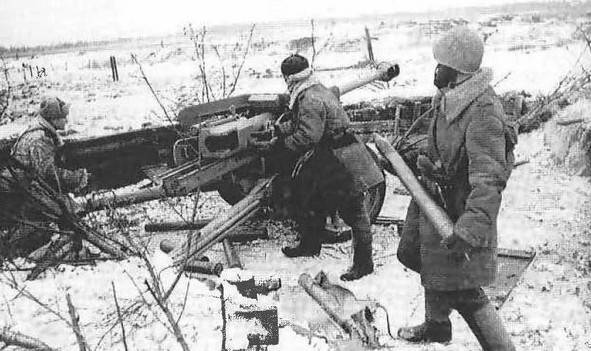
As you know, the main enemy tanks anti-tank artillery was on the battlefield during the Second World War. By the time Nazi Germany attacked the Soviet Union, the Wehrmacht's infantry units in quantitative terms had a sufficient number of anti-tank guns. Another thing is that the 37-50-mm guns available in the troops could successfully fight armored vehicles with bulletproof armor. And they turned out to be ineffective against the modernized T-28E medium tanks (with shielded armor), the new T-34 medium tanks and the KV-1 heavy ones.
37 mm anti-tank gun 3,7 cm Pak. 35/36
37-mm cannon Rak. 35/36 was the main anti-tank weapon with which Germany entered the war with the USSR. The first modification of the anti-tank gun, known as the Tak. 28 (German Tankabwehrkanone 28), was created by Rheinmetall-Borsig AG in 1928. After field trials, a modified 37 mm Tak cannon appeared. 29, which went into mass production.
The Reichswehr adopted this weapon in 1932, receiving a total of 264 units. Tak cannon. 29 had a 45 caliber barrel with a horizontal wedge gate, which provided a rate of fire of up to 20 rds / min. The carriage with sliding tubular beds provided a large horizontal guidance angle - 60 °, but the chassis with wooden wheels was designed only for horse traction.
In the late 1920s, this weapon was the best in its class, far ahead of developments in other countries. It was exported to about a dozen countries. 12 of these guns were delivered to the USSR, and another 499 were manufactured under license in the early 1930s. It was accepted into service under the name: 37 mm anti-tank gun mod. 1930 The famous Soviet 45-mm anti-tank gun model 1932 - traces its ancestry to the German Tak. 29.
But this gun, due to the impossibility of towing it with mechanical traction, did not fully satisfy the German military. In 1934, a modernized version appeared, with wheels equipped with pneumatic tires that can be towed by a car, an improved carriage and an improved sight. Under the designation 3,7 cm Pak. 35/36 (German Panzerabwehrkanone 35/36) was adopted by the Wehrmacht as the main anti-tank weapon.
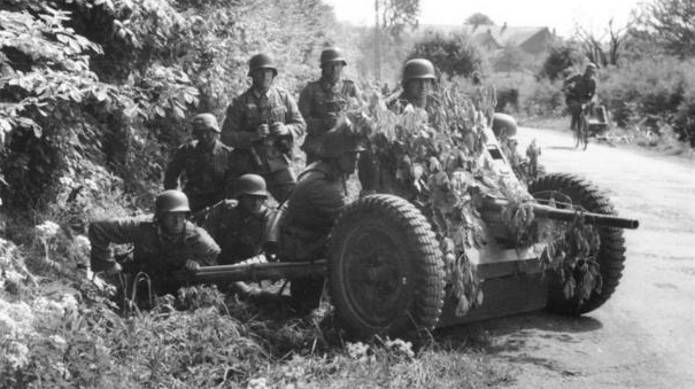
Calculation of the 37 mm anti-tank gun 3,7 cm Pak. 35/36 in a firing position.
The presence of a wedge-type automatic shutter closing mechanism provided a rate of fire of 12-15 rounds per minute. The sector of the horizontal shelling of the gun was 60 °, the maximum elevation angle of the barrel was 25 °. The mass of the gun in the combat position is 480 kg, which made it possible to roll it by the crew of 5 people.
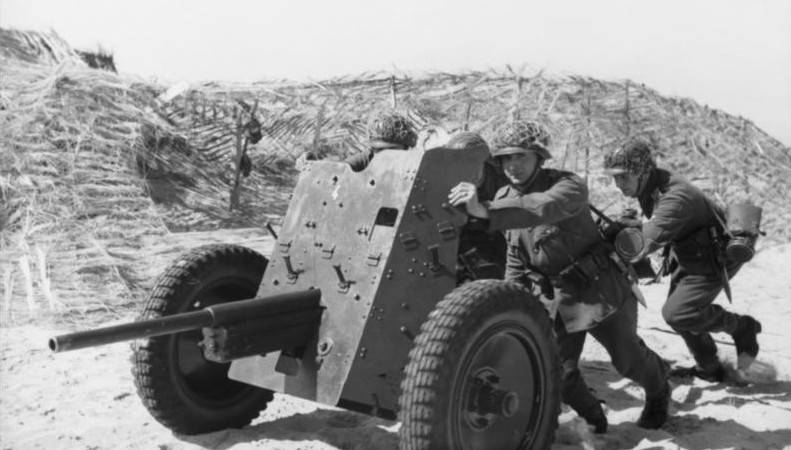
Ammunition for each gun was 250 rounds. The main shot was considered to be with an armor-piercing projectile of 3,7 cm Pzgr. 36 (120 rounds in ammunition), there were also shots with reel-type sub-caliber projectiles 3,7 cm Pzgr. 40 (30 shots) and 100 shots with a fragmentation projectile 3,7 cm Sprg. 40.
An armor-piercing 37-mm projectile weighing 0,685 kg left the barrel at a speed of 745 m / s, and at a distance of 300 m at a meeting angle of 60 ° it could penetrate 30-mm armor. A sub-caliber projectile weighing 0,355 kg with an initial speed of 1020 m / s under the same conditions pierced 40 mm armor.
The shrapnel shell weighed 0,62 kg and contained 44 g of explosives. In addition, for the cannon Rak. 35/36, a special over-caliber cumulative ammunition Stiel.Gr. 41 weighing 9,15 kg was developed, containing 2,3 kg of explosives and fired with a blank powder charge. The armor penetration of a cumulative mine with a maximum firing range of 300 m, along the normal was 180 mm.
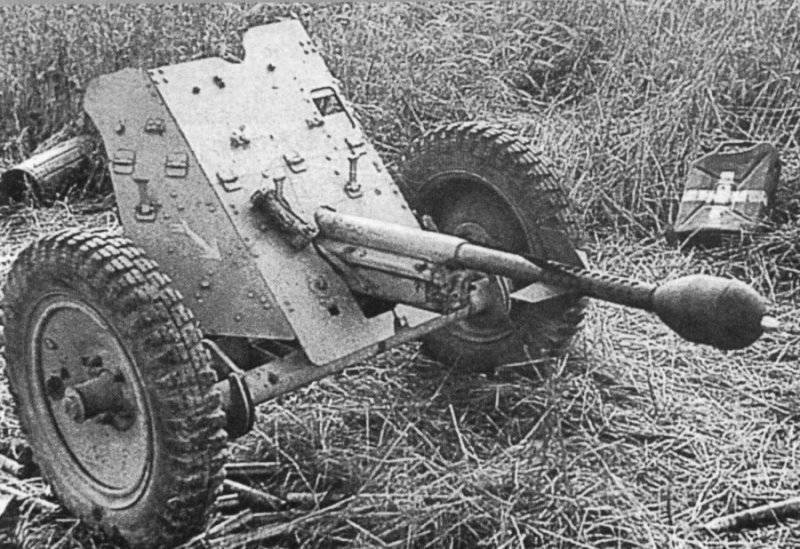
Anti-tank gun 3,7 cm Pak. 35/36 with over-caliber cumulative mine Stiel.Gr. 41
In the Wehrmacht, each infantry division of the first line according to the states of 1940 was supposed to have 75 Pak guns. 35/36.
As of September 1, 1939, the German armed forces had 11 Cancer cannons. 250/35. By June 36, 22, this number increased to a record 1941 units, but subsequently steadily declined. On March 15, 515, the Wehrmacht and the SS troops still had 1 Cancers. 1945/216, and 35 of these guns were stored in warehouses. In total, about 36 thousand Rak guns were fired. 670/16.
Most of the infantry divisions switched to more powerful guns in 1943, but they remained in the parachute and mountain divisions until 1944, and in the fortified areas, occupation units and formations of the second line until the end of the war. Due to their compactness and low weight, 37-mm anti-tank guns in some cases performed well in street battles at the final stage of hostilities.
Taking into account the fact that the 37-mm cannon Cancer. 35/36 were very widespread in the armed forces of Nazi Germany, they often became trophies of the Red Army.
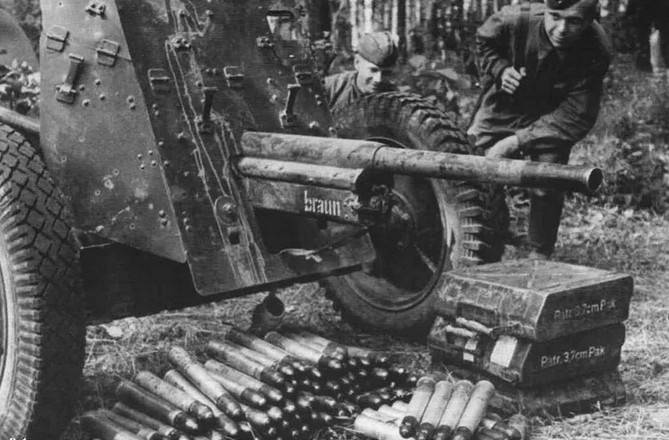
The first cases of the use of captured 37-mm guns were noted in July 1941. But regularly cannons Cancer. 35/36 were used against enemy armored vehicles in the fall of 1941.
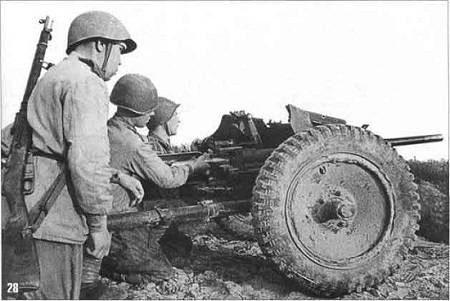
Formally, when using standard armor-piercing shells, the 37-mm anti-tank gun Cancer. The 35/36 was inferior to the Soviet 45 mm anti-tank gun of the 1937 model.
So, according to the declared characteristics, an armor-piercing 45-mm projectile B-240, when meeting at a right angle at a distance of 500 m, pierced 43-mm armor. At the same distance, when hit at a right angle, a German armor-piercing shell pierced 25 mm armor. However, in the initial period of the war, the armor penetration of the 37-mm German and 45-mm Soviet anti-tank guns was approximately the same.
This is due to the fact that Soviet armor-piercing shells in 1941 did not meet the declared characteristics. Due to a violation of production technology, when colliding with armor plates, 45-mm shells split, which greatly reduced armor penetration. A number of sources say that the real penetration of a 45-mm projectile was only 20-22 mm at 500 m.
At the same time, a 45-mm O-240 fragmentation grenade weighing 2,14 kg contained 118 g of TNT. And in terms of fragmentation, it more than doubled the 37-mm German fragmentation projectile. 45-mm grenade O-240 when bursting gave about 100 fragments, retaining lethal force when flying along the front by 11-13 m and in depth by 5-7 m.
Soviet troops in late 1941 - early 1942, in the course of counterattacks near Tikhvin and Moscow, captured several dozen serviceable Rak guns. 35/36. This made it possible to arm a number of newly formed anti-tank battalions with captured guns.
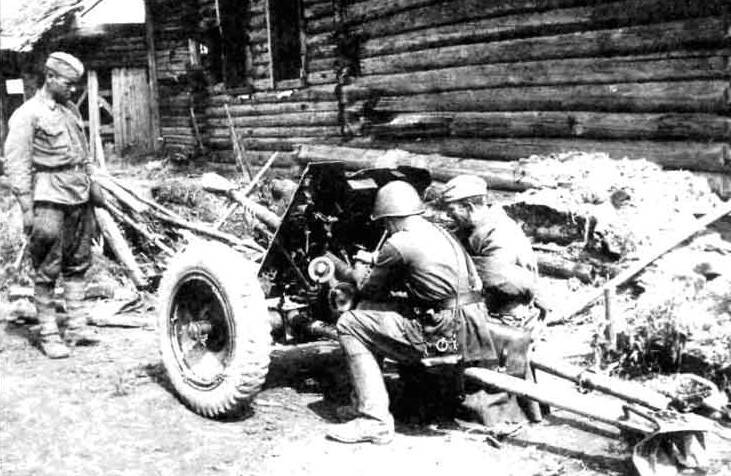
In addition, German-made light 37-mm cannons were very often used as a freelance anti-tank weapon for rifle units. Since 3,7 cm Cancer. 35/36 and 45-mm cannon mod. 1937 of the year were structurally very close, with the development and use of 37-mm captured anti-tank guns there were no special problems.
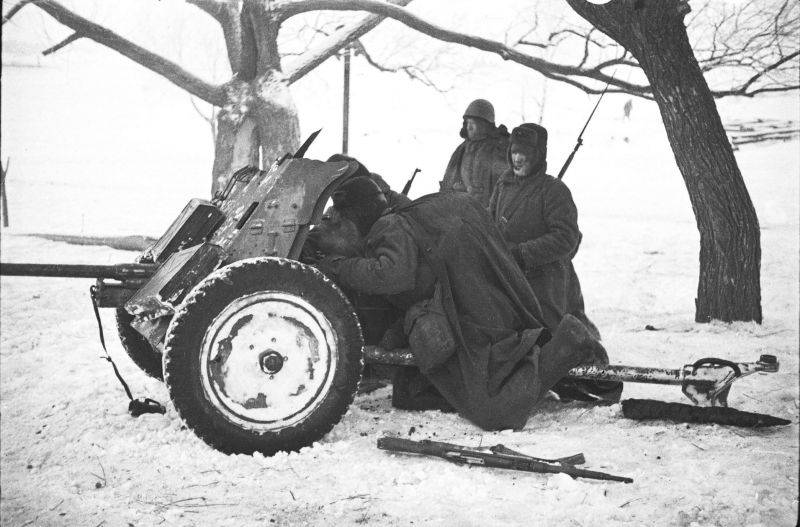
Soviet crew fires a captured German 37-mm anti-tank gun
Combat characteristics Cancer. 35/36 tanks in the initial period of the war made it possible to successfully fight early modifications of the German medium tanks Pz.Kpfw.III and Pz.Kpfw.IV, as well as light Pz.Kpfw.II, PzKpfw. 35 (t) and PzKpfw. 38 (t ).
However, as the protection of German armored vehicles grew and the anti-tank units of the Red Army were saturated with effective domestic 45, 57 and 76-mm guns, the use of 37-mm captured anti-tank guns stopped.
47 mm anti-tank gun 4,7 cm Pak 36 (t)
In the initial period of the war on the Eastern Front, the Wehrmacht was in dire need of more powerful anti-tank guns. As a temporary measure, the 47-mm Czechoslovak-made 4,7 cm kanon PUV cannons were widely used. vz. 36, which in the German armed forces received the designation 4,7 cm Pak 36 (t). In terms of armor penetration, the Czechoslovak-made gun was only slightly inferior to the German 50-mm 5 cm Pak gun. 38. Similar guns captured in Yugoslavia were designated 4,7 cm Pak 179 (j).
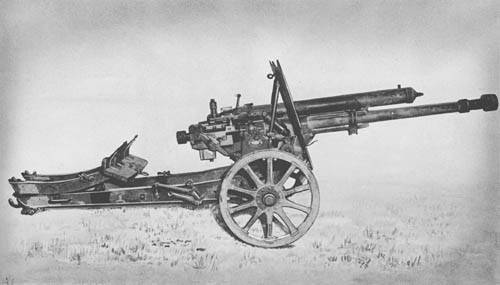
Anti-tank gun 4,7 cm kanon PUV. vz. 36
Anti-tank gun 4,7 cm kanon PUV. vz. 36 was developed by Škoda in 1936 as a further development of the 37 mm 3,7 cm kanon PUV.vz.34 gun. Externally, the gun is 4,7 cm kanon PUV. vz. 36 was similar to the 3,7 cm kanon PUV.vz. 34, differing in a larger caliber, overall dimensions and weight, which increased to 595 kg. For ease of transportation, both frames of the 47-mm cannon were folded and turned 180 ° and attached to the barrel.
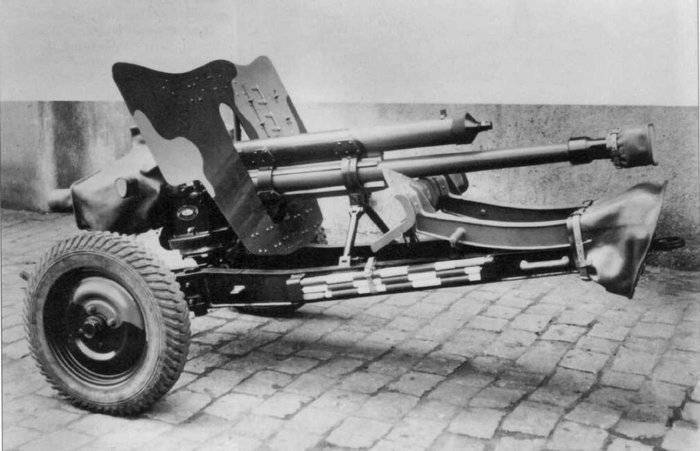
47-mm anti-tank gun 4.7 cm kanon PUV. vz. 36 in transport position
As of 1939, the 47 mm Czechoslovakian gun was one of the most powerful in the world. With a barrel length of 2219 mm, the muzzle velocity of 1,65 kg of the armor-piercing projectile was 775 m / s. At a distance of 1000 m at a right angle, the projectile pierced 55 mm armor. A well trained crew could make 15 rds / min.
In 1940, the 47 cm Pzgr. 4,7 cm Pzgr. 40 with tungsten carbide core. A projectile weighing 0,8 kg with an initial speed of 1080 m / s at a distance of up to 500 m confidently pierced the frontal armor of a medium Soviet T-34 tank. In addition, there was a round with a fragmentation projectile weighing 2,3 kg, which contained 253 g of TNT.
Before the occupation of Czechoslovakia in March 1939, 775 47 mm guns were fired. Most of them went to the Germans. Production of 47 mm guns continued until 1942. More than 1200 examples were built in total. The 47 mm anti-tank guns 4,7 cm Pak 36 (t) were actively used until early 1943, when the German anti-tank divisions received a sufficient number of 50 and 75 mm guns.
In addition to being used in a towed version, some of the 4,7 cm Pak 36 (t) guns were sent to arm anti-tank self-propelled guns. From March 1940, Czech 47-mm cannons began to be installed on the chassis of the Pz.Kpfw.I Ausf B light tank, and from May 1941 on the chassis of a captured French R-35 tank. A total of 376 light tank destroyers were manufactured. Self-propelled guns, designated Panzerjager I and Panzerjäger 35 R (f), respectively, entered service with tank destroyer divisions.
47 mm anti-tank gun 4,7 Pak. 35/36 (ö)
In addition to the 47-mm guns of Czech production, the Wehrmacht had guns of a similar caliber, obtained after the Anschluss of Austria. In 1935, the Austrian company Böhler created the original 47 mm Böhler M35 gun, which could be used as anti-tank, mountain and light infantry. Depending on the purpose, the 47 mm gun had different barrel lengths and could be equipped with a muzzle brake.
A collapsible modification was also mass-produced, suitable for transportation in packs. A common feature of all models was a large elevation angle, the absence of a splinter shield, as well as the ability to separate the wheel travel, and install directly on the ground, which reduced the silhouette in the firing position. To reduce the mass in the transport position, some of the late-production guns were equipped with wheels with light-alloy wheels.
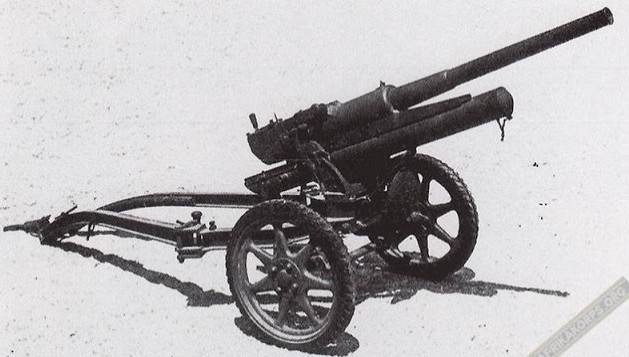
47-mm anti-tank gun Böhler M35
Although the design of the gun had a number of controversial solutions due to the requirements of versatility, it was quite effective in the role of an anti-tank gun. The modification with a barrel length of 1680 mm in the transport position weighed 315 kg, in combat, after separation of the wheel travel - 277 kg. Combat rate of fire 10–12 rds / min.
The ammunition contained fragmentation and armor-piercing shells. A fragmentation projectile weighing 2,37 kg had an initial velocity of 320 m / s and a firing range of 7000 m. An armor-piercing tracer projectile weighing 1,44 kg left the barrel at a speed of 630 m / s. At a distance of 100 m along the normal, it could penetrate a 58-mm armor plate, at 500 m - 43-mm, at 1000 m - 36-mm. A modification with a barrel length of 1880 mm at a distance of 100 m was capable of penetrating 70 mm armor.
Thus, the 47-mm Böhler M35 gun, with acceptable weight and size characteristics at all distances, could successfully fight armored vehicles protected by bulletproof armor, at short range - with medium tanks with anti-shell armor.
The Wehrmacht received 330 guns from the Austrian army, and about 150 more guns were collected from the existing stock before the end of 1940. Austrian 47-mm guns were adopted under the designation 4,7 Pak. 35/36 (ö). Taking into account the fact that the Böhler M35 guns were actively exported, Germany got the Dutch guns, which received the name 4,7 Pak. 187 (h), and the former Lithuanians captured in the warehouses of the Red Army - designated 4,7 Pak. 196 (r).
The guns, manufactured in Italy under license, were designated Cannone da 47/32 Mod. 35. After Italy's withdrawal from the war, the Italian guns that were trapped by the Germans were called 4,7 Pak. 177 (i). Part of the 47-mm Böhler M35 cannons was used to arm improvised tank destroyers.
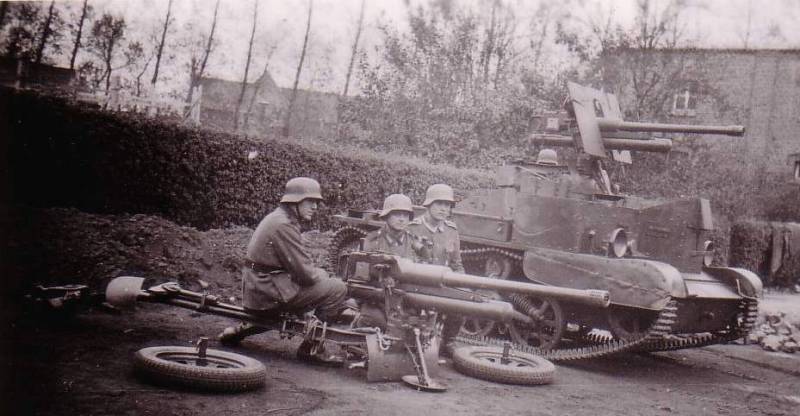
In June 1941, the Wehrmacht had at its disposal about 500 47-mm Austrian-made guns. Until mid-1942, they actively fought on the Eastern Front. Subsequently, the guns that survived and captured in Italy were transferred to Finland, Croatia and Romania.
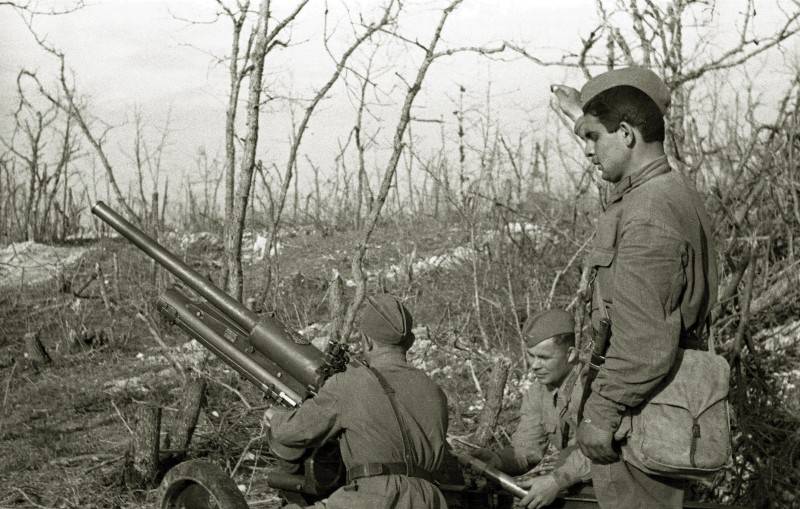
Soviet gun crew at a position near Sevastopol firing from a 47-mm Austrian-made gun, spring 1942
In Soviet documents, captured 47-mm anti-tank guns of Czechoslovak and Austrian production appeared as 47-mm guns of the Skoda system and the Bohler system.
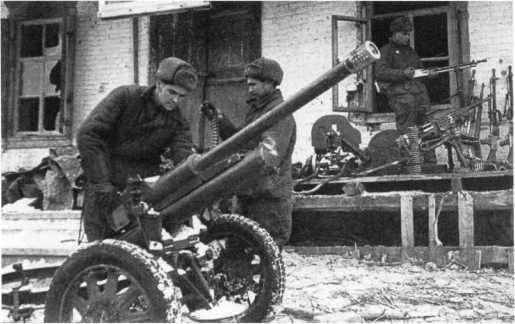
Soldiers of the Red Army inspect a 47-mm gun of Austrian production, captured in the vicinity of Stalingrad, December 1942
Now it is impossible to say for sure how many of these guns were captured by the Red Army, but it can be confidently asserted that in the presence of ammunition, they were used against the former owners.
50 mm anti-tank gun 5 cm Pak. 38
Anti-tank 50 mm gun 5 cm Pak. 38 was created by Rheinmetall-Borsig AG in 1938 and was intended to replace the 37 mm Pak cannon. 35/36. However, due to organizational inconsistencies and technical difficulties, the first 50-mm cannons entered the army only at the beginning of 1940.
Large-scale production began only at the end of 1940. As of June 1, 1941, the troops had 1047 guns. Release of 5 cm Pak. 38 was completed in 1943, a total of 9568 50 mm anti-tank guns were produced.
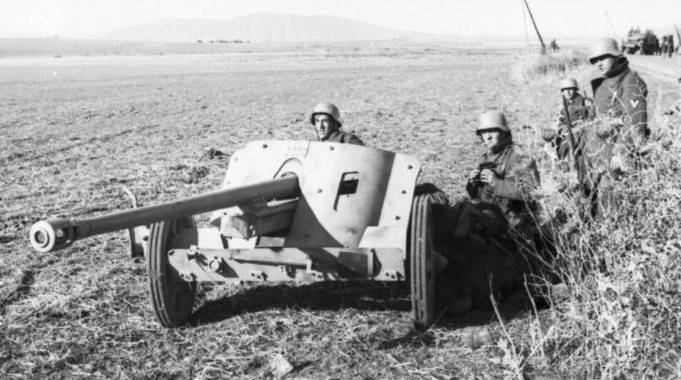
50 mm anti-tank gun 5 cm Pak. 38 with the expectation of a firing position
At the time of its appearance, the 50-mm German anti-tank gun had very good armor penetration characteristics, but for this caliber it was overweight. Its mass in the combat position was 930 kg (the much more powerful Soviet 57-mm ZiS-2 in the combat position weighed 1040 kg).
An armor-piercing projectile 5 cm Pzgr. 39 weighing 2,05 kg, having accelerated in a barrel with a length of 60 calibers to a speed of 823 m / s, at a distance of 500 m along the normal penetrated 70-mm armor. At a distance of 100 m, 95 mm armor could be pierced. The 5 cm Pzgr. 40 sabot projectile weighing 0,9 kg had an initial velocity of 1180 m / s. And under the same conditions, it could penetrate 100 mm armor. The ammunition load also included shots with a 5 cm Sprgr. 38 fragmentation grenade weighing 1,81 kg, which contained 175 g of explosives.
When firing with armor-piercing shells, the Pak anti-tank gun. 38 most likely penetrated the side armor of the T-34 medium tank from 500 m. The T-300's frontal armor penetrated at a distance of less than 50 m. For subcaliber 34-mm shells, the Soviet T-700 medium tank was vulnerable at a distance of up to 1942 m, but due to the shortage of tungsten, after XNUMX, shots with sub-caliber shells became rare in the ammunition of German anti-tank guns.
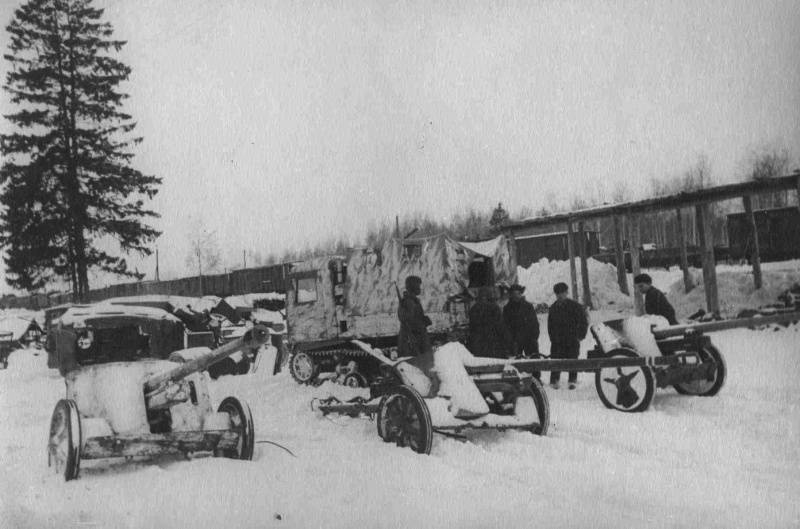
For the first time, a significant number of 5 cm Pak guns. 38 with a stock of shells, our troops captured near Moscow. Even more 50-mm anti-tank guns were among the trophies of the Red Army after the defeat of the Germans at Stalingrad.
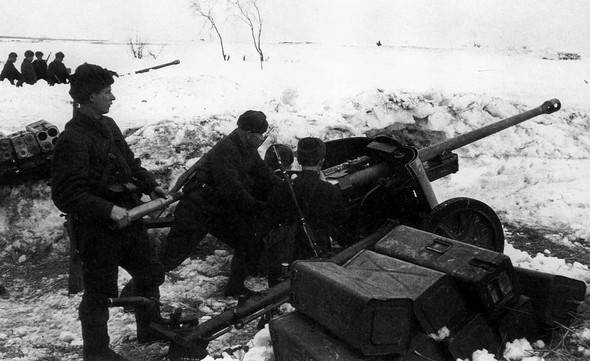
In 1943, captured 50 mm 5 cm Pak cannons. 38 firmly settled in the Soviet anti-tank artillery. They entered service with individual anti-tank divisions. And they were used in conjunction with domestic 45, 57 and 76,2 mm guns.
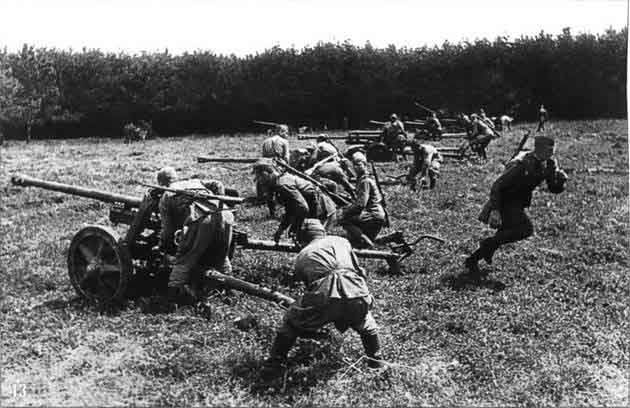
According to the ability to combat enemy armored vehicles Pak. 38 was close to the Soviet 76-mm ZiS-3 gun, which was used in divisional and anti-tank artillery.

For towing 50-mm guns of German production in the Red Army, horse teams were used, as well as trophy tractors and transporters obtained under Lend-Lease.
After the seizure of the strategic initiative by the Red Army and the transition to large-scale offensive operations, our troops received many German anti-tank guns. Captured 50-mm guns provided fire support to the Soviet infantry and covered tank-dangerous areas until the last days of the war.
It is known that in the framework of the rearmament program of the Bulgarian army ("Barbara plan"), in 1943 the Germans supplied 404 50-mm anti-tank guns.
After Bulgaria declared war on Germany in September 1944, these guns were used against German troops. Part of the Bulgarian anti-tank artillery was lost in the battle. As of January 1, 1945, there were 362 Pak in stock. 38.
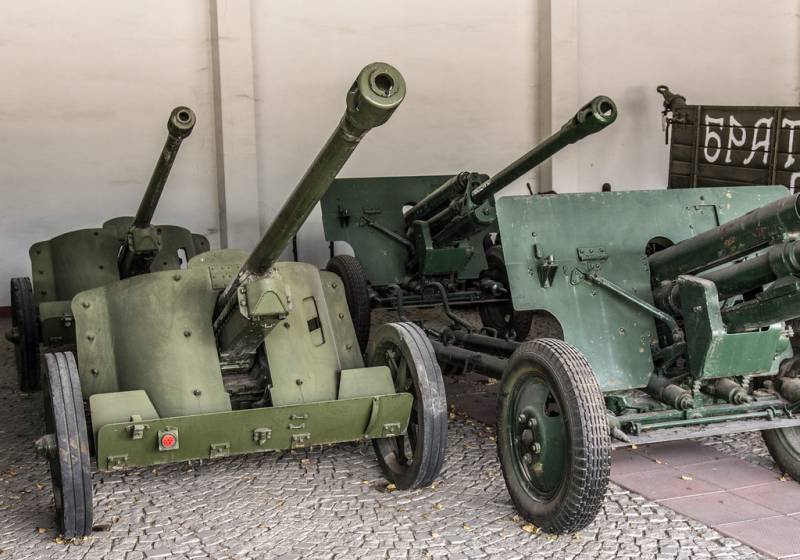
50mm Pak anti-tank guns. 38 next to 76-mm Soviet divisional guns ZiS-3 in the Bulgarian National Military History Museum
During the hostilities, units of the Bulgarian People's Army were able to recapture several dozen Pak guns from the enemy. 38, thus restoring their original numbers. In the late 1940s, almost all Pak available. 38 were stationed in a fortified area on the border with Turkey. German 50-mm cannons were in service with the Bulgarian army until the mid-1960s.
The first German 50-mm anti-tank guns appeared in the People's Liberation Army of Yugoslavia (NOAJ) in early 1943, when the soldiers of the 1st Proletarian Division captured several 5 cm Pak. 38 and successfully used them in March 1943 in the battles on the Neretva.
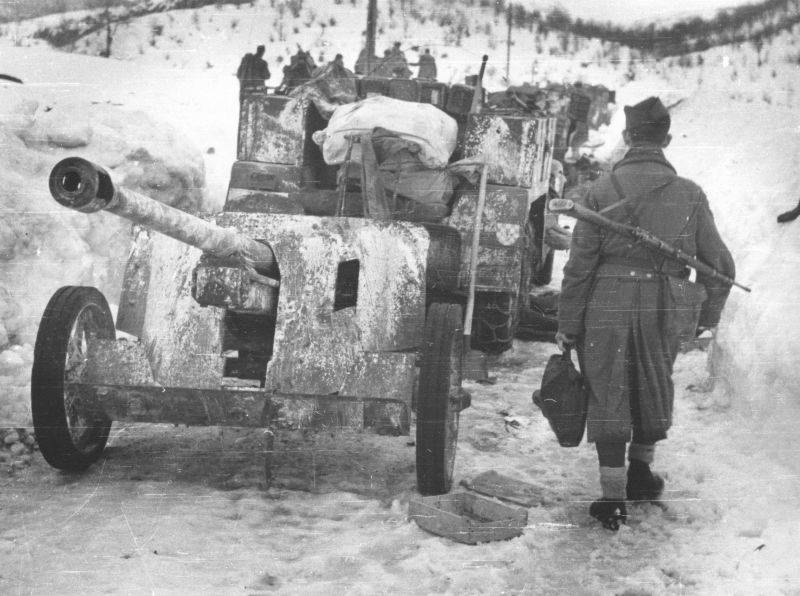
A NOAU soldier at a column of captured 50 mm Pak anti-tank guns. 38
After the liberation of the country's territory from the Nazis, the Yugoslavs got several dozen 50-mm guns, and they were operated in the combat units of the NOAJ until the early 1950s.
On July 1, 1945, there were more than 400 Pak anti-tank guns suitable for further use in the artillery units of the Red Army and at the collection points of weapons. 38. In the post-war period, captured 50-mm guns were used for practice shooting.
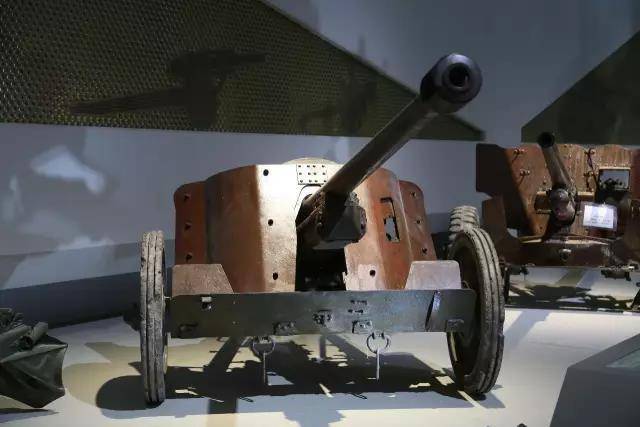
50 mm anti-tank gun 5 cm Pak. 38 on display at the War Museum of the Chinese Revolution
After China sent people's volunteers to participate in the Korean War, the Soviet government handed over to Beijing a large batch of captured German weapons and ammunition. In addition to rifles, machine guns, howitzers and mortars, 50 mm 5 cm Pak anti-tank guns were supplied. 38, which subsequently fought in Korea along with the 45 mm M-42, 57 mm ZiS-2 and 76,2 mm ZiS-3.
75 mm anti-tank gun 7,5 cm Pak. 40
In terms of the range of service, operational, combat characteristics and taking into account the cost of production, the 7,5 cm Pak can be considered the best German anti-tank gun. 40. This cannon was designed by Rheinmetall-Borsig AG on the basis of a 5 cm Pak. 38. Externally 7,5 cm Pak. 40 is very similar to the 5 cm Pak. 38, and are often confused in photographs.
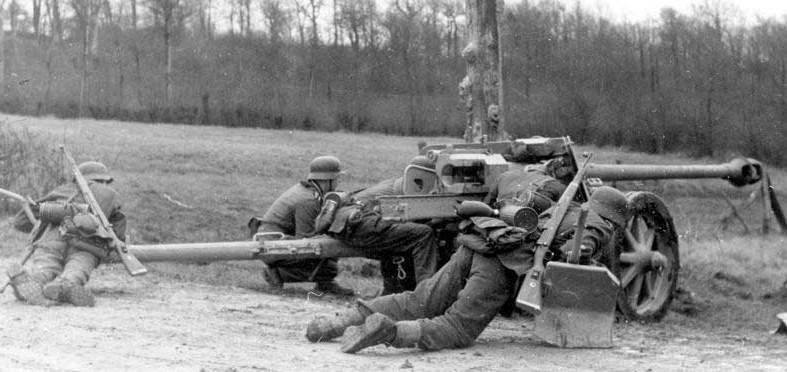
75 mm anti-tank gun 7,5 cm Pak. 40 in firing position
In the late autumn of 1941, it became clear to German generals that the blitzkrieg had not taken place, and the number of Soviet tanks with anti-cannon armor on all fronts began to steadily increase. Taking into account the fact that the existing 37-50-mm anti-tank guns for fighting them were officially recognized as insufficient, in November 1941, the 75-mm Pak gun entered service. 40.
The Wehrmacht received the first 15 guns only in February 1942. Until March 1945, more than 20 guns were produced, some of them were used to arm the tank destroyers. On March 000, 1, the troops had 1945 towed 4695-mm Pak 75 anti-tank guns.
Due to the acute shortage of anti-tank weapons capable of fighting the new medium and heavy Soviet tanks, at the first stage in each infantry division fighting on the Eastern Front, in the anti-tank battalion, it was supposed to replace one platoon of 37-mm guns with a platoon of 7,5 cm Pak. 40, which was supposed to contain only two guns. According to the staffing table, approved in February 1943, the infantry division was supposed to have 39 guns. For towing a 7,5 cm Pak. 40, it was required to use only mechanized traction, with a shortage of standard traction, using captured tractors.
The mass of the gun in combat position was 1425 kg. Barrel length - 3450 mm (46 calibers). Rate of fire - up to 15 rds / min. Armor-piercing shell 7,5 cm Pzgr. 39 weighing 6,8 kg left the barrel with an initial speed of 792 m / s. At a distance of 500 m along the normal, it could penetrate 125 mm armor, at 1000 m - 100 mm.
An APCR shell 7,5 cm Pzgr. 40 with a mass of 4,1 kg with an initial speed of 933 m / s, from 500 m along the normal it pierced 150 mm armor. Cumulative 7,5 cm Gr. 38 Hl / B weighing 4,4 kg, from any distance, at right angles, could penetrate 85 mm armor. Also in the ammunition load there were shots with high-explosive fragmentation grenades 7,5 cm Sprgr. 34. This grenade weighed 5,74 kg and contained 680 g of explosives.
After the appearance of the 7,5 cm Pak guns on the Soviet-German front. 40 anti-tank artillery of the Wehrmacht got the opportunity to fight against Soviet tanks at almost all distances of real combat. The exception was the IS-2 of the late series, their foreheads confidently kept the hits of 75-mm armor-piercing shells. After 1943, shots with subcaliber shells from the ammunition load of German 75-mm anti-tank guns disappeared.
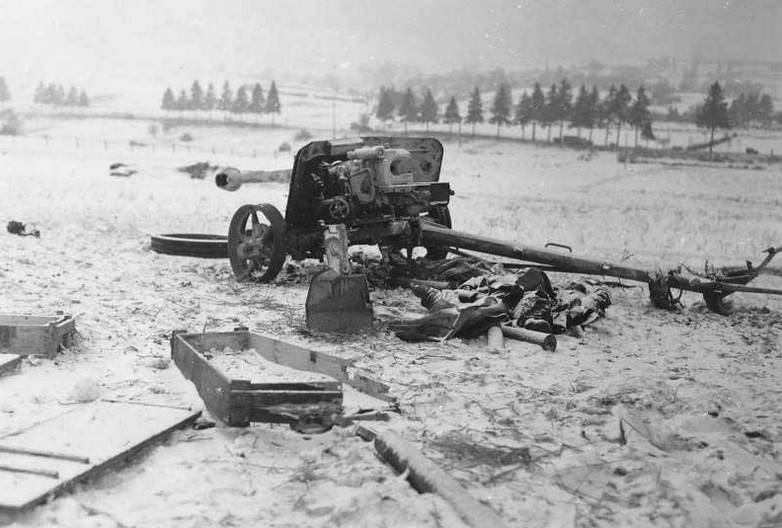
Even after the start of mass production of 75-mm guns, the troops always lacked them. German industry was unable to supply the troops with the required number of anti-tank guns. Most of the 7,5 cm Pak. 40, who fought on the Eastern Front, were lost on the battlefield, up to 500 guns were captured by the Red Army.
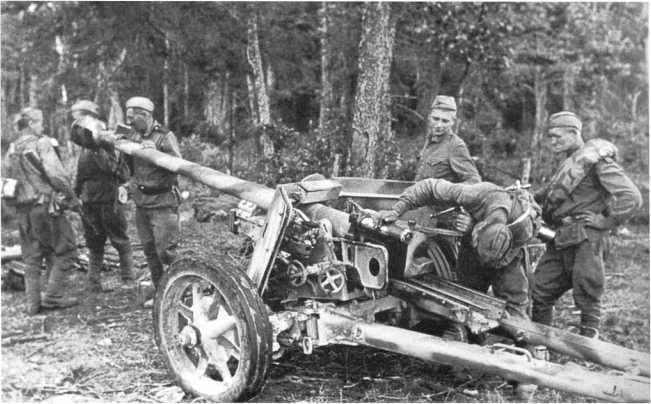
Soviet artillerymen appreciated the capabilities of the 7,5 cm Pak. 40. The German 75-mm gun could confidently fight medium and heavy tanks at a distance of up to 1 km. The Soviet 76,2 mm ZiS-3 cannon had the ability to hit 80 mm Tiger side armor with an armor-piercing projectile at a distance of less than 300 m. At the same time Pak. 40, when fired, the openers "buried" more strongly in the ground, as a result of which the ZiS-3 was far behind in the ability to quickly change position or transfer fire.
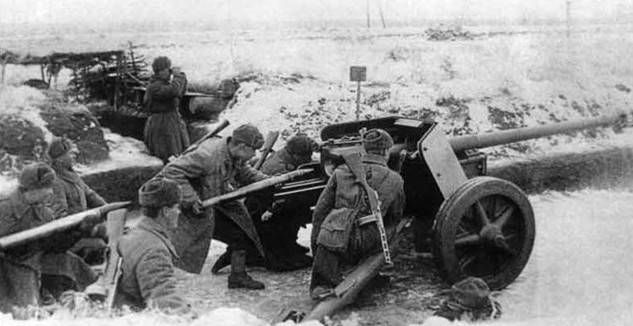
Captured guns 7,5 cm Pak. 40 in the Red Army were considered as an anti-tank reserve and were actively used to combat enemy armored vehicles. As with the 5 cm Pak. 38, 75-mm anti-tank guns were sent to manning individual anti-tank battalions or were used as a means of reinforcing units armed with artillery guns of domestic production.
Pak anti-tank guns. 40 Germany supplied Hungary, Slovakia, Finland, Romania and Bulgaria. With the transition of the last three in 1944 to the anti-Hitler coalition Pak. 40, available in the armed forces of these countries, were used against the Germans.
75mm Pak gun. 40 were in service with a number of European armies after the end of World War II. So, in Czechoslovakia and in France, the production of 75-mm shells was established. Operation of captured Pak guns. 40 in these countries lasted until the first half of the 1960s.
In 1959, the Soviet Union handed over the stored 7,5 cm Pak guns to the Democratic Republic of Vietnam. 40. Initially, the 75-mm cannon was considered as an anti-tank weapon and was intended to repel possible aggression from the south. However, they subsequently served in coastal defense until the early 1980s.
76 mm anti-tank gun 7,62 cm Pak. 36 (r)
Very interesting story 76,2 mm anti-tank gun 7,62 cm Pak. 36 (r).
This gun was converted from the Soviet F-22 divisional gun, which the Germans captured about 1000 units in the initial period of the war.
In September 1941, the captured Soviet F-22 division was adopted by the Wehrmacht under the designation 7,62 cm FK 296 (r). Since it was not possible to capture a significant number of 76,2-mm armor-piercing shells, German enterprises began to produce an armor-piercing shell 7,62 cm Pzgr. 39, which had better armor penetration than the Soviet UBR-354A. In November, a sub-caliber shell 7,62 cm Pzgr was introduced into the ammunition load. 40. With new anti-tank rounds, the FK 296 (r) guns were used on the Eastern Front and in North Africa.
However, even taking into account the successful use of captured F-22 in North Africa and on the Soviet-German front, these guns were not optimal for use in anti-tank defense. German calculations complained about inconvenient guidance organs located on different sides of the shutter. A lot of complaints also caused a sight. In addition, the power of the gun was still not enough to confidently break through the frontal armor of the heavy Soviet KV-1 tanks and British heavy infantry tanks Churchill Mk IV.
Since the F-22 gun was originally designed for a much more powerful ammunition and had a large margin of safety, by the end of 1941 a project was developed to modernize the F-22 into the 7,62 cm Pak anti-tank gun. 36 (r). The captured guns mod. 1936, the chamber was bored, which made it possible to use a sleeve with a large internal volume.
The Soviet sleeve had a length of 385,3 mm and a flange diameter of 90 mm. The new German sleeve was 715 mm long with a flange diameter of 100 mm. Thanks to this, the powder charge was increased by 2,4 times. Due to the increased recoil, a muzzle brake was installed. In fact, German engineers returned to the fact that V.G. Grabin proposed in 1935.
The transfer of the handles of the gun guidance drives to one side with a sight made it possible to improve the working conditions of the gunner. The maximum vertical angle was reduced from 75 ° to 18 °. In order to reduce weight and visibility at the position of the gun received a new armor shield of reduced height.
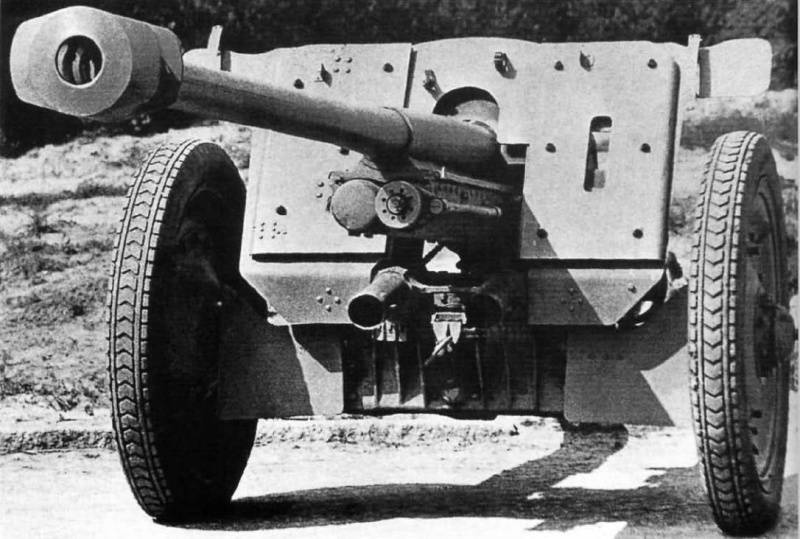
76,2 mm anti-tank gun 7,62 cm Pak. 36 (r)
Thanks to the increased muzzle energy, it was possible to significantly increase the armor penetration. German armor-piercing tracer with a ballistic tip 7,62 cm Pzgr. 39 weighing 7,6 kg had an initial speed of 740 m / s and at a distance of 500 m along the normal could penetrate 108 mm armor.
In smaller numbers, shots were fired with the 7,62 cm Pzgr.40 APCR shell. At an initial speed of 990 m / s, a projectile weighing 3,9 kg at a distance of 500 m at right angles pierced 140 mm armor. The ammunition load could also include cumulative shells 7,62 cm Gr. 38 Hl / B and 7,62 cm Gr. 38 Hl / C with a mass of 4,62 and 5,05 kg, which (regardless of range) normally provided penetration of 85-90 mm of armor. And high-explosive shells.
In terms of armor penetration, the 7,62 cm Pak. 36 (r) was very close to the German 7,5 cm Pak. 40, which was the best mass-produced in Germany during the war years in terms of cost, a complex of service, operational and combat characteristics.
It can be stated that both guns confidently ensured the defeat of medium tanks at real firing ranges. But at the same time, the 7,5 cm Pak. 40 is lighter than the 7,62 cm Pak. 36 (r) approx. 100 kg. Conversion of the Soviet F-22 divisional gun into the 7,62 cm Pak anti-tank gun. 36 (r) was, of course, justified, since the cost of rework was many times cheaper than the cost of a new gun.
Before mass production of the 7,5 cm Pak. 40 anti-tank gun 7,62 cm Pak. 36 (r), converted from the Soviet F-22 "division," was the most powerful German anti-tank artillery system. Taking into account the high armor penetration and the fact that the total production of 7,62 cm Pak. 36 (r) exceeded 500 units, they are in 1942-1943. had a significant impact on the course of hostilities.
Our troops captured several dozen 7,62 cm Pak 36 (r) after the defeat of the Germans at Stalingrad. After assessing the potential of the "double captured" guns, they were included in the anti-tank destroyer divisions. These guns were also used to shell enemy positions with high-explosive fragmentation shells - that is, they performed the tasks of divisional artillery. However, the active combat use of the 7,62 cm Pak 36 (r) in the Red Army lasted only a few months. Captured guns fought as long as there was ammunition for them.
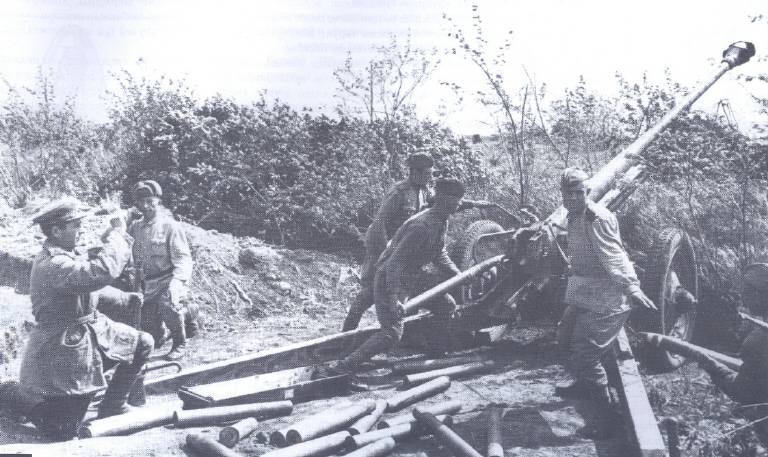
At the beginning of 1943, based on the experience of using the 7,62 cm Pak 36 (r), the Soviet command proposed V.G. Grabin to create a similar weapon for a shot from a 76,2-mm anti-aircraft gun mod. 1931 year. However, taking into account the fact that the production of the F-22 divisional guns was stopped, and there were few previously fired guns in the troops, such a decision was considered not rational.
88 mm anti-tank gun 8,8 cm Pak. 43
Considering the excellent anti-tank capabilities of the 88-mm anti-aircraft guns, the famous "aht-aht", the German military leadership decided to create a specialized anti-tank gun in this caliber. The need for a very powerful anti-tank gun was dictated by the predicted increase in the protection of Soviet heavy tanks and self-propelled guns. Another stimulus was the lack of tungsten, which was then used as a material for the cores of the sub-caliber projectiles of the 75 mm Pak cannon. 40. The construction of a more powerful weapon opened up the possibility of effectively hitting heavily armored targets with conventional steel armor-piercing shells.
In 1943, the Krupp company (using parts of the anti-aircraft Flak. 41) created the 8,8 cm Pak anti-tank gun. 43, which demonstrated outstanding armor penetration performance. It could hit the frontal armor of tanks at a distance of up to 2,5 km. Armor-piercing tracer shell 8,8 cm Pzgr. 39/43 weighing 10,2 kg left a barrel 71 caliber long with an initial speed of 1000 m / s. At a distance of 1000 m at a meeting angle of 60 °, he pierced 167 mm armor. At a distance of 2000 m, 135 mm armor pierced under the same conditions.
An APCR shell 8,8 cm Pzgr. 40/43 weighing 7,3 kg with an initial speed of 1130 m / s at a distance of 1000 m at a meeting angle of 60 ° pierced a 190-mm armor plate. The ammunition load also included shots with a cumulative grenade 8,8 cm Gr. 38/43 HI with 110 mm normal armor penetration and with a 9,4-kg 8,8 cm Sprgr high-explosive fragmentation grenade. 43, containing 1 kg of TNT.
A gun with a rate of fire of up to 10 rounds per minute could confidently fight any tanks that took part in the battles of World War II. At the same time, the excessive weight of the 8,8 cm Pak anti-tank gun. 43 limited her mobility.
The weapon known as the Pak. 43/41, mounted on the carriage of the 105-mm leFH field howitzer. 18, similar to the carriage of the 75mm Pak anti-tank gun. 40. The mass of the artillery system in the combat position was 4400 kg, in the stowed position - 4950 kg. For transporting Pak. 43 required a sufficiently powerful tracked tractor.
The cross-country ability of the tractor-implement hitch on soft soils was unsatisfactory. The tractor and the gun it towed were vulnerable on the march and when deployed to a combat position. In addition, in the event of a flank attack by the enemy, it was difficult to turn the Pak gun. 43/41 in the threatened direction.
A variant was also produced on a specialized cruciform carriage, inherited from an anti-aircraft gun. But such carriages were not enough, they were complicated and expensive to manufacture.
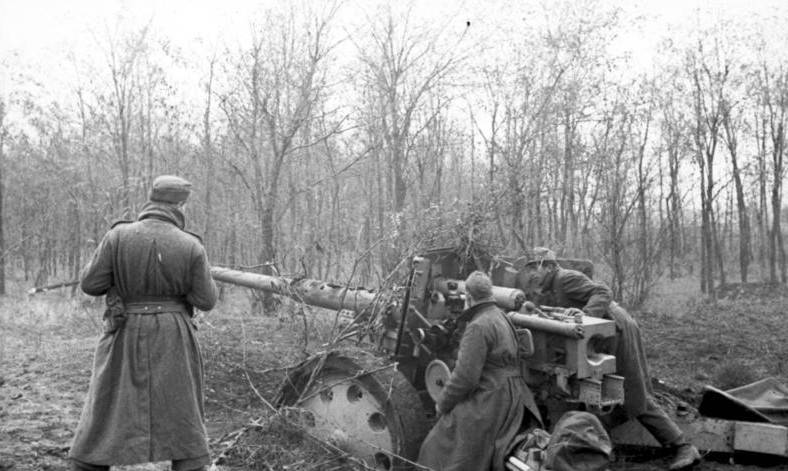
88 mm Pak anti-tank gun. 43/41 in firing position
The 88 mm anti-tank gun made its debut on the battlefield in the second half of 1943, and its production continued until 1945. The first to receive this gun were specialized anti-tank divisions. At the end of 1944, the guns began to enter service with the artillery corps. Due to the complexity of production, high metal consumption and cost, only 3502 of these guns were produced.
Almost from the very beginning of the Pak. 43 suffered heavy losses. Taking into account the fact that the 88-mm anti-tank guns could not quickly leave the firing position, in the event of a flanking bypass by the enemy, it was impossible to quickly evacuate them. Due to their high silhouette and bulkiness, these weapons were difficult to camouflage on the ground.
It is now impossible to say how many 88-mm anti-tank guns were captured by the Red Army. But taking into account the fact that they were released a little, we can talk about several dozen.
Penetration characteristics of Pak guns. 43 allowed them to successfully fight all types of heavy German tanks and self-propelled artillery installations. But at the final stage of the war, German armored vehicles were used mainly in defense, and did not often appear in front of our artillery positions.
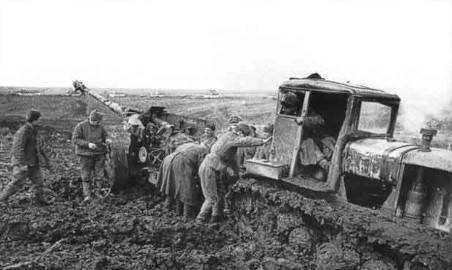
In addition, the calculations of captured 88-mm anti-tank guns very soon became convinced that their transportation and changing positions were very difficult. Even powerful tracked tractors were not always able to tow these guns off-road.
Although the Pak cannon. 43 was developed to combat armored vehicles, it had good capabilities to destroy targets deep in enemy defenses.
The firing range of an 88-mm high-explosive fragmentation grenade exceeded 15 km, and most often captured heavy anti-tank guns were involved in counter-battery combat or fired harassing fire at targets in the rear of the Germans.
In the post-war period, several 8,8 cm Pak guns. 43 were taken to training grounds, where they were used to test the security of new Soviet tanks.
To be continued ...
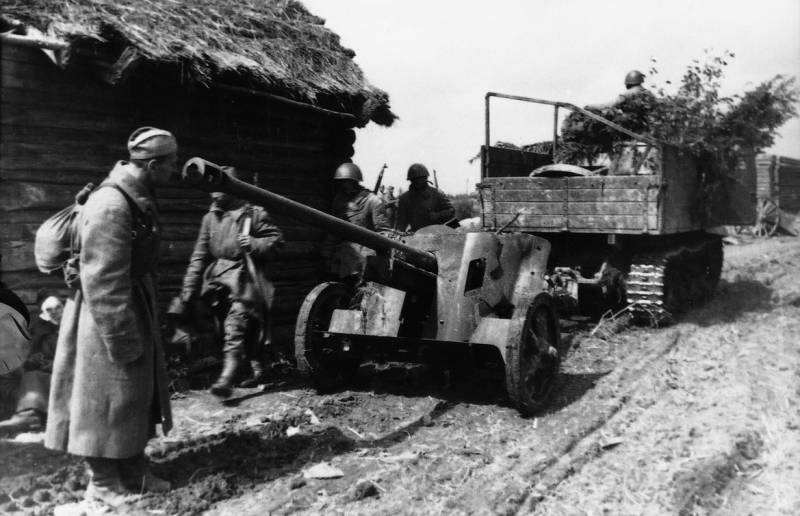
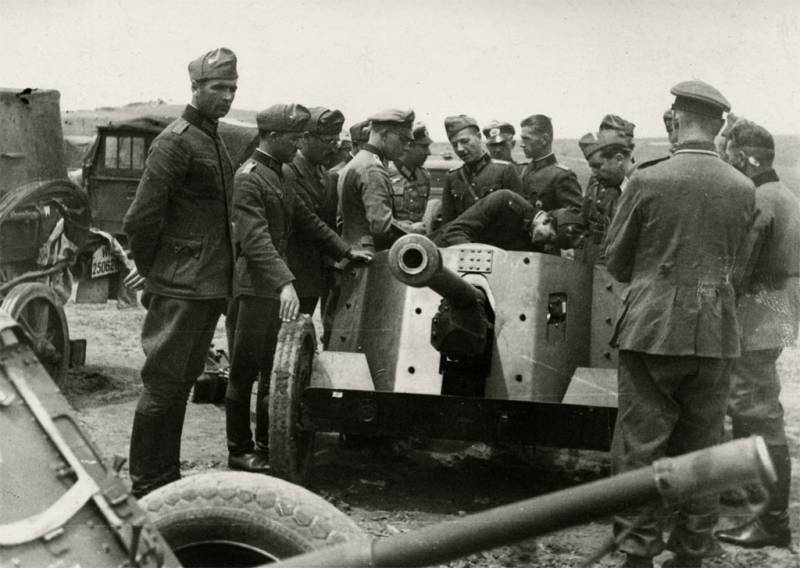
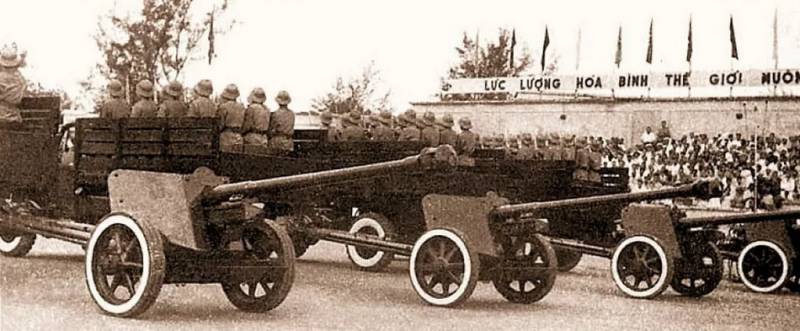
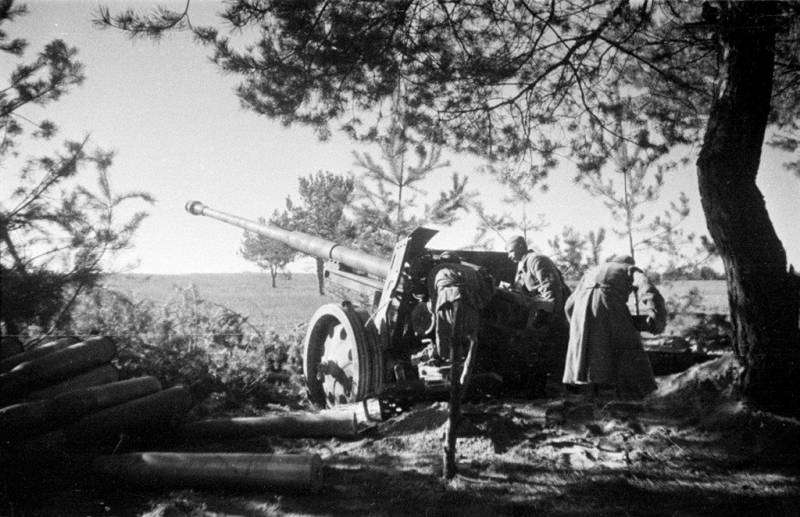
Information